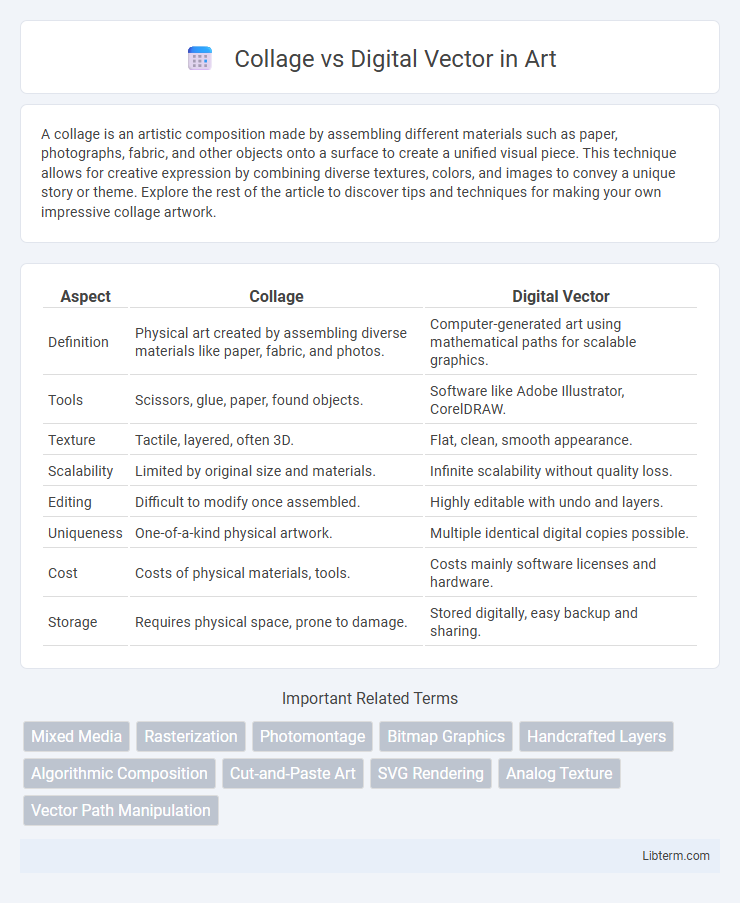A collage is an artistic composition made by assembling different materials such as paper, photographs, fabric, and other objects onto a surface to create a unified visual piece. This technique allows for creative expression by combining diverse textures, colors, and images to convey a unique story or theme. Explore the rest of the article to discover tips and techniques for making your own impressive collage artwork.
Table of Comparison
| Aspect | Collage | Digital Vector |
|---|---|---|
| Definition | Physical art created by assembling diverse materials like paper, fabric, and photos. | Computer-generated art using mathematical paths for scalable graphics. |
| Tools | Scissors, glue, paper, found objects. | Software like Adobe Illustrator, CorelDRAW. |
| Texture | Tactile, layered, often 3D. | Flat, clean, smooth appearance. |
| Scalability | Limited by original size and materials. | Infinite scalability without quality loss. |
| Editing | Difficult to modify once assembled. | Highly editable with undo and layers. |
| Uniqueness | One-of-a-kind physical artwork. | Multiple identical digital copies possible. |
| Cost | Costs of physical materials, tools. | Costs mainly software licenses and hardware. |
| Storage | Requires physical space, prone to damage. | Stored digitally, easy backup and sharing. |
Introduction to Collage and Digital Vector
Collage art involves assembling various materials such as paper, fabric, and photographs to create a unified composition, emphasizing texture and physical layering. Digital vector art, created using software like Adobe Illustrator, relies on mathematical equations to produce scalable, clean, and precise graphics ideal for logos and illustrations. Understanding the foundational differences between collage's tactile approach and vector art's digital precision is essential for effective visual communication.
Defining Collage Art
Collage art involves assembling various materials such as paper, photographs, fabric, and other found objects onto a surface to create a layered, textured composition. This tactile approach contrasts with digital vector art, which relies on computer-generated shapes and lines that are scalable without loss of quality. Collage emphasizes physical manipulation and material diversity, while digital vectors prioritize precision and smooth, clean edges.
Understanding Digital Vector Art
Digital vector art relies on mathematical equations to create scalable images, ensuring sharpness and clarity at any size. Unlike collage, which combines physical or digital images through layering and texture, vector art uses paths, anchor points, and curves for precise, editable graphics. Mastery of digital vector tools enables artists to produce clean, versatile designs ideal for logos, illustrations, and animations.
Key Differences Between Collage and Digital Vector
Collage involves assembling physical materials like paper, fabric, and photographs to create textured, layered artwork with tangible depth. Digital vector art uses mathematical equations to produce scalable graphics that maintain clarity and sharpness at any size. Key differences include the tactile, handcrafted nature of collage versus the precision, scalability, and easy editability of digital vector creations.
Creative Process: Traditional vs Digital
Collage involves manually assembling various physical materials, fostering tactile creativity and spontaneous experimentation in the traditional creative process. Digital vector art uses software tools that enable precise control over shapes and layers, allowing for easy revisions and scalability without loss of quality. The traditional collage process emphasizes texture and materiality, whereas digital vector creation prioritizes clean lines and editable components.
Tools and Materials Used
Collage art typically uses physical tools and materials such as paper, scissors, glue, magazines, and various textured elements to create layered compositions. Digital vector art relies on software like Adobe Illustrator or CorelDRAW, utilizing tools such as pen, shape, and anchor point editors to create scalable, clean, and precise graphics. The tactile nature of collage contrasts with the precision and flexibility of digital vectors, allowing artists to choose based on their creative needs and desired visual effects.
Flexibility and Editing Capabilities
Digital vector graphics offer superior flexibility with scalable, resolution-independent designs easily adjustable without loss of quality, making precise edits and reconfigurations straightforward. Collage techniques involve layering physical or digital images, which can limit editing since changes often require dismantling or recreating parts of the composition. Vector editing software enables dynamic modifications to shapes, colors, and layers, whereas collage methods rely more on manual adjustments and are less adaptable for ongoing revisions.
Popular Uses and Applications
Collage art is widely used in mixed media projects, scrapbooking, and advertising due to its tactile and layered aesthetic that combines various materials like paper, fabric, and photographs. Digital vector graphics are favored in logo design, web development, and animation because of their scalability without loss of quality and precise geometric shapes. Both techniques serve distinct creative purposes, with collage excelling in textured, multidimensional expression and digital vector excelling in clean, scalable, and versatile imagery for commercial and digital platforms.
Pros and Cons of Collage and Digital Vector
Collage offers tactile textures and a unique, handcrafted aesthetic that enhances visual storytelling through physical materials, but it can be time-consuming and less flexible for edits. Digital vector graphics provide scalable, precise designs ideal for logos and web use, allowing easy modifications and consistent quality across platforms, yet they may lack the organic, spontaneous feel of traditional collage. Choosing between collage and digital vector depends on the project's need for customization, flexibility, and artistic expression.
Choosing the Right Style for Your Project
Choosing between collage and digital vector art depends on your project's goals and desired aesthetic. Collage offers a tactile, textured feel perfect for expressive, layered designs, while digital vector provides crisp, scalable graphics ideal for logos and clean illustrations. Assess your audience, medium, and branding needs to select the style that best enhances your visual communication.
Collage Infographic

 libterm.com
libterm.com